Jaromir (CRAY T3E)
Jaromir was a scalable parallel T3E system. The initial 256-processor configuration expanded to 512 processors. Over the span of its service, from 1996 to 2004, Jaromir provided 25 million CPU hours to more than 3,000 researchers.
PSC’s Jaromir was the first production T3E system shipped from Cray Research.
Research
Some of the important research enabled by Lemieux is highlighted here. To see more, check the Projects in Scientific Computing archive.
Structure of Proteins and DNA: Watch a Protein Fold
Peter Kollman, University of California, San Francisco
In 1997, Kollman and his coworkers Yong Duan and Lu Wang developed software that exploits parallel systems like the T3D and CRAY T3E much more effectively than before. They then simulated the folding of a small protein in water for a full microsecond, 100 times longer than previous simulations. The result is a more complete view of how one protein folds – a look at what hasn’t been seen before, offering new insight into the folding process.
Read the full article: https://www.psc.edu/science/Kollman98/kollman98.html.
Structure of Proteins & DNA: Long Distance Charges
Peter Kollman and Thomas Cheatham, University of California at San Francisco
Mike Crowley, Pitsburgh Supercomputing Center
Working closely with Tom Darden of the National Institute of Environmental Health Scienceand Cheatham, PSC biomedical scientist Mike Crowley simulated DNA, RNA and proteins with results that herald new possibilities for computational biology.
Read the full article: https://www.psc.edu/science/Kollman/kollman.html
Structure of Proteins and DNA
Charles L. Brooks III, Scripps Research Institute
Brooks has used computational simulations to better understand the complex relations between sequence and structure. His work on the protein folding problem, as this relation is known, has helped to build theory that explains protein folding in terms of the energy changes of the atom-to-atom interactions. Explorations of a protein’s energy landscape are very large computational problems, but they represent an alternative to even more costly simulations that track the protein over the complete time span of its folding.
